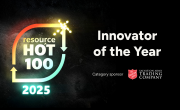How blockchains can track waste materials through supply chains
Blockchain-enabled supply chain technology paves the way for responsible purchasing decisions at every step of a supply chain, promising a paradigm shift towards a truly circular economy. Ellen Carey, VP of Public Affairs and Global Policy at Circulor, explains.

In the future, we will be able to probe exactly where – and how – materials that make up our everyday products were mined (either out of the ground or elsewhere), we will be able to track the precise journey they took as they physically transform into the goods that we find in our stores, and we will then witness exactly how those products go on to be recycled into something new.
Supply chain traceability unlocks a whole new realm of responsible decision-making and product innovation. It gives businesses full visibility of the exact volumes of virgin and used materials on the marketplace and facilitates collaboration across diverse suppliers. As a result, businesses gain the economic advantages of circular economies, reduce their direct and indirect CO2 emissions, and keep key resources within production cycles. In turn, this stimulates supply chain resilience and builds stronger and more stable economies for the customers they serve.
Growing demand for truth
Society is changing. Younger generations are committed to sustainability, and they are exercising that commitment by educating themselves on the products that they buy, ensuring that their purchase power supports the advancement of responsible, sustainable production. New research from the WWF reports that consumer demand for sustainable products has grown by 71 per cent over the past five years, with an ‘eco-wakening gripping the globe’. That demand is now being reflected on product labels and a call for substantiated proof that product and company claims are in fact what they say they are.
The technology industry has been responding to this growing demand, and how it has translated into the company, investor, and regulatory requirements for supply chain transparency. Major tech advancements in edge computing, cloud computing, and software – like blockchain and machine learning – have made it possible to illuminate the world’s most complex industrial supply chains, offering massive benefits for businesses, economies and our planet. In fact, analysis from the World Economic Forum recently showed that, by 2030, digital technologies will have the potential to help save 20 per cent of global CO2 emissions.
Blockchain technology: making it possible today
Blockchain technology enables organisations to gain visibility into their supply chains, demonstrate responsible and ethical sourcing, and prove their environmental, social, and corporate governance (ESG) goals as well as their greenhouse gas (GHG) emissions.
A ‘blockchain’, also known as a distributed ledger, is a set of discrete data records (blocks) that are inextricably and securely linked to each other. Each ‘block’ of information contains encrypted data from the previous block to make a secure ‘chain’ without the possibility of modifying or faking this information. This enables the secure flow of information with transactions recorded and verified via an immutable chain of custody that builds trust between businesses.
A set of protocols, or ‘rules’ govern any blockchain; determining what information the blocks should contain, and the manner in which that information is recorded, without the need for third-party verification. These protocols can be set up to record what materials or products are where, in what condition, and at what point in their life cycle.
Circulor’s own platform assigns a digital identity to a material at a mine site or source; we physically tag actual metals with a QR code or near-field communications (NFC) tag to create a digital twin. The platform then tracks the material along its chemical and industrial transformation journey with the digital twin gathering data such as mass balance, elapsed time and proof of location from scan points throughout the supply chain as the physical material changes state at each stage of production, recycling, and end-of-life.
Smart contracts verify the chain of custody before any records are committed to the ledger and we use machine learning and business logic to detect data anomalies. Finally, we assign direct, indirect, and attributable GHG emissions through dynamic carbon accounting to provide a view of the CO2 attribution from each supply chain participant at batch level.
“When you have a reliable chain of custody, you can start to attach other information to that flow of materials, because you not only know who the actors are, but you also know the identity of the material as it changes state,” says Douglas Johnson-Poensgen, founder and CEO of Circulor. “Then we start to attach ESG metrics to that flow of material so the customer can start to develop intelligence about sourcing from different suppliers.”
The rise of digital product identifiers
Blockchain and the suite of edge and cloud computing technologies that are available today will enable the exponential growth of material- and item-level identifiers for billions of products. The frontier for product identifiers — or product passports as they’re often referred — is happening now in the electric vehicle (EV) battery space.
Batteries contain highly valuable critical raw minerals with potentially high environmental and human rights impacts. They’re also a critical technology for electrifying the world’s power and transportation sectors, reducing our dependence on fossil fuels, and proving new economies of recycling and circularity.
The EU Battery Regulation that is currently underway by the European Commission is seen as setting the blueprint for requirements that prove responsible content, ethical sourcing, and embedded carbon for products and their entire value chains. Each battery will be required to have a digital “battery passport” as early as 2026, demonstrating its compliance with due diligence guidelines, its embedded carbon emissions, and recycled content targets.
A data management system, enabled by blockchain technology, will make the information about these batteries available to defined stakeholders in the European battery ecosystem – customers, providers, suppliers, refurbishers, recyclers, and more. This creates a technological ecosystem that allows for transparent, safe and secure information sharing which is the main enabler of a truly circular economy.
Battery producers can take specific steps to reduce energy consumption and costs while reaping a price premium by demonstrating ESG-certified batteries. For automakers, transparency means reduced liability risk and also reduced costs for handling batteries at end-of-life. Collectors and recyclers increase their recycling yield and improve efficiencies. All the while customers gain access to information they’ve never had before as to what is in their product, its state of health, and its value on the market.
The United States seems to be following suit when it comes to batteries. Recent requirements in the Inflation Reduction Act presume that battery sourcing and production could be known down to a car’s Vehicle Identification Number. Like Europe, the long-term benefit will be incentives that enable a digitally-enabled, circular economy of important items that will decarbonize key sectors of the economy.
 This article was taken from Issue 104
This article was taken from Issue 104Beyond Batteries
The EU Battery Regulation is setting the precedence for the application of digital product passports more broadly. The EU is also working on regulations in the form of an Ecodesign for Sustainable Products Regulation and a Corporate Sustainability Due Diligence Directive (CS3D) that will extend requirements to products and materials beyond batteries to track the physical flow of materials and demonstrate their responsible, sustainable, and circular production via digital information sharing.
Industry leaders are seeing this societal shift coming in product management and are starting the journey to incorporate digitalization and blockchain technologies.
One example is TRACKCYCLE: a consortium between TotalEnergies, Recycling Technologies (sadly now in administration) and Circulor. Using blockchain technology, TRACKCYCLE provided TotalEnergies with fully traceable and accurate labelling of recycled plastic materials, from waste sourcing up to the use of recycled polymers in new production streams. Stakeholders had far greater visibility of the provenance and quality of the materials entering and exiting their plastic production facilities, making it easier to provide evidence of the amount of recycled content used. This is particularly timely given the UK Government’s Plastic Packaging Tax with exemptions for producers that can prove 30 per cent or more recycled plastic content, and the European Union introducing a similar packaging levy.
Conclusion
New global standards and requirements are being set in terms of disclosing the specific contents of products being sold. If companies embrace emerging technologies to manage material flows, they can tap unprecedented potential in terms of reduced risks and costs. They can also become engines of positive change for society, responsible stewards of the environment, and resilient and reliable contributors to economic growth. In fact, the entire global population stands to benefit.





